Encapsulating a Crawl Space: How to Improve Your Home and Health
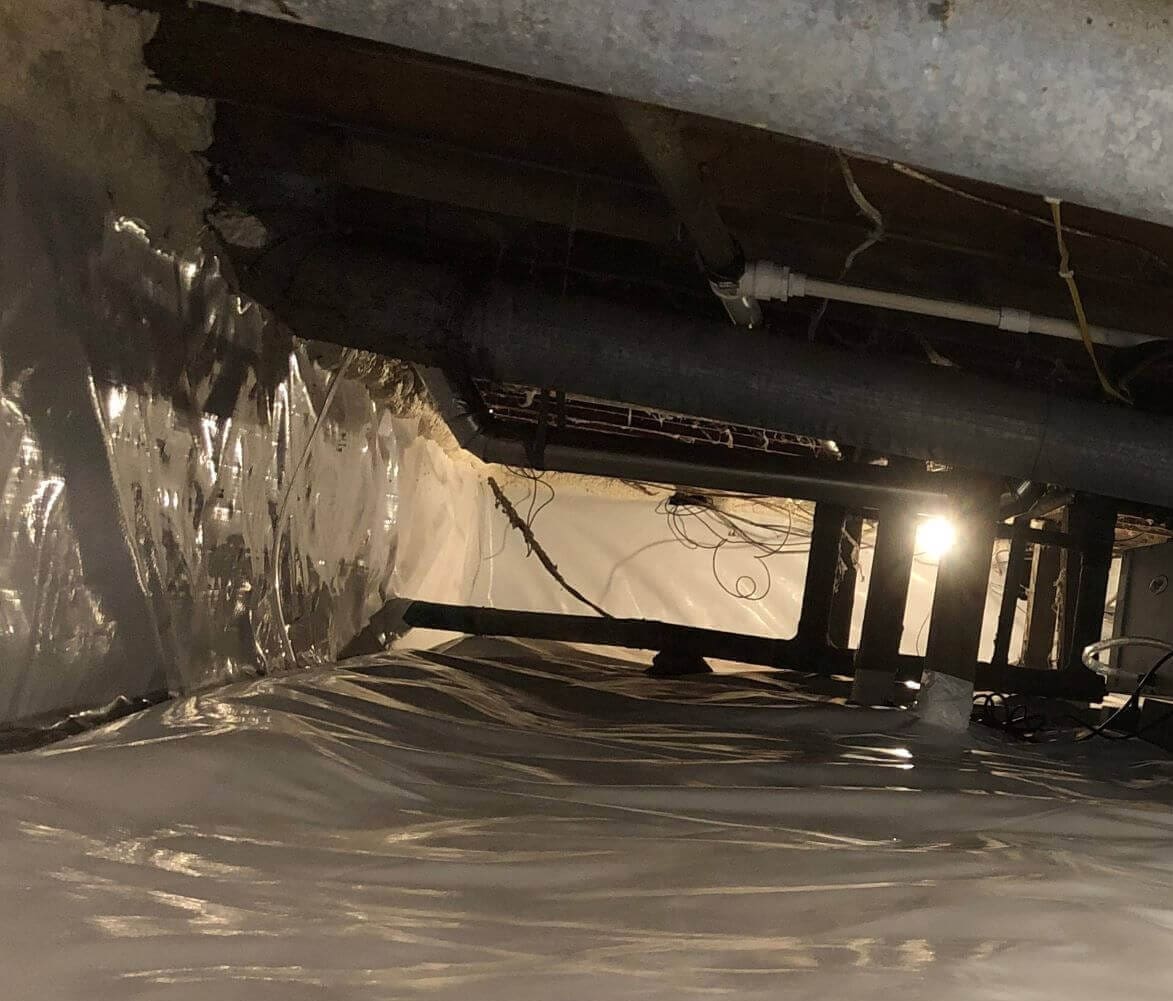
originally posted 1/23/20; updated 7/7/23
When your HVAC kicks on, does it circulate a damp, stale smell that makes you wrinkle your nose? Do you suffer from cold or allergy symptoms that disappear while you’re at work, only to return shortly after you return home? Is your floor starting to creak, sag, or slope to one side?
These are all signs that your home’s crawl space is unhealthy and desperately needs your attention.
Acculevel has been helping people with foundation repairs and waterproofing since 1996, and we can promise you this: excessive moisture will break down just about every element of your crawl space. This can have major consequences for the health of your family, your home, and your bank account.
We’re going to define what crawl space encapsulation is, how it’s done, then detail how it benefits you and your home. Here’s a hint: crawl space encapsulation will improve indoor air quality, increase energy efficiency, and protect the structural integrity of your flooring system.
How Does Crawl Space Encapsulation Work?
Encapsulating a crawl space will transform it from a dark and grim area into a clean and sterile space. A makeover this significant will take a few steps, however.
Encapsulating Your Crawl Space Starts with Waterproofing
Have you ever been in your crawl space? Do you know if it often has standing water in it or if it’s normally dry? You don’t need frequent or constant water intrusion to develop a problem; even an occasionally damp crawl space can cause damage.
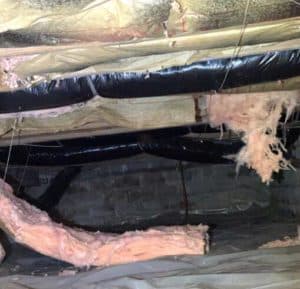 This photo was taken by an Acculevel project advisor during a free home assessment.
This photo was taken by an Acculevel project advisor during a free home assessment.
The picture above shows a common situation: the fiberglass insulation has absorbed moisture, gradually weighing it down until it falls. You can see traces of former water intrusion along the foundation walls; the white marks are efflorescence, minerals left behind after moisture has evaporated. If you look closely, you can also see signs of mold growth on the insulation wrap.
Waterproofing Basics
Every interior water drainage system requires two components: a drainage track and a sump pump. The drainage track is installed around the perimeter of the crawl space to collect any water that seeps through your home’s foundation. Drainage may also be run across the crawl space if it frequently pools up or collects on the dirt floor. The water track channels water to the sump pump, which is usually placed at a naturally low point.
The picture below shows you what an installed sump pump (with battery backup) looks like. The PVC pipe is the drainage line that expels the water from the pump out into the yard. You can also see some plastic liner in the nearest corner; this is a vapor barrier that should always be spread over the top of a crawl space “floor” to prevent gasses, odors, and vapors from evaporating and tainting the air quality inside your home.
 This photo of a sump pump and discharge line was taken by an Acculevel crew member after waterproofing a customer’s crawl space.
This photo of a sump pump and discharge line was taken by an Acculevel crew member after waterproofing a customer’s crawl space.
Make Necessary Crawl Space Repairs
Before you start encapsulation, you should make sure the entire crawl space is in good condition:
- If you have mold or other biological growth, this should be treated after the moisture issue is resolved.
- Defective or damaged insulation should be removed — if it isn’t, the moisture in the old insulation will soon be home to any mold spores in the space.
- If the wet insulation or moist air has caused decay in the floor joists, sill plate, or other flooring components, these should also be repaired.
- Have questions about how to accomplish these critical tasks? Check out our detailed – and free! – crawl space repair guide.
How the Crawl Space Encapsulation Process Is Done
Encapsulation is like installing a pool liner inside your crawl space, except it keeps water out instead of in.
The Right Material is Crucial
When you encapsulate a crawl space, using the best liner available is important. At Acculevel, we use 100% virgin resin polyethylene. This will not support mold or mildew growth, blocks moisture, and is puncture resistant. It also protects against soil gasses evaporating far better than lower-quality vapor barriers.
How Encapsulation Is Applied
The thick, heavy lining material is placed throughout the crawl space. It will cover the floor and the walls. If you have concrete pillars that support your main beam, the material will be wrapped around the base of these as well. Seams are taped, sealed, and then secured to the walls.
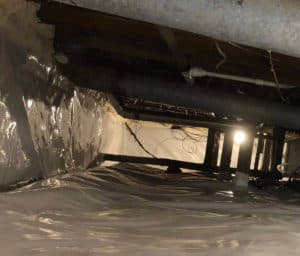 This picture was taken by an Acculevel crew member after completing encapsulation.
This picture was taken by an Acculevel crew member after completing encapsulation.
Ventilation and Insulation Are Next
After the liner is in place, the crawl space vents are closed. You don’t want mold spores, moisture, or pollen getting into your crawl space air! We’ll talk more about indoor air quality in the next section.
Spray foam insulation is applied to the perimeter of the foundation, where the crawl space foundation wall meets the wooden flooring structure. This is usually along the sill plate and in the joist boxes (the open spaces between the floor joists against the bandboard along the outside wall). These are the places where temperature variations are most likely to occur, so improving insulation here will improve energy efficiency.
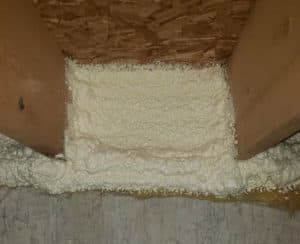 This is an example of spray foam insulation applied to a joist box and sill plate.
This is an example of spray foam insulation applied to a joist box and sill plate.
While the spray foam is not an adhesive, it does set up quickly and forms a tight seal. By applying it along the top of the encapsulation material, it ensures that the liner will not come loose from the top of the wall.
Finally, a Whole-Home Dehumidifier Is Installed
As a final guard against humidity and moisture buildup, a large-capacity dehumidifier should be installed. Condensation is going to form in a crawl space; the variations between indoor and outdoor air guarantee this. A whole-home dehumidifier can be programmed to maintain a specific humidity level, which will help keep your air quality at its best: clean, fresh-smelling, and free of irritants and pollutants.
FAQ: Why Waterproof Before You Encapsulate Your Crawl Space
If you rarely have a wet crawl space, you may think skipping directly to encapsulation is a way to reduce the budget and save time. However, it will only take one heavy rainstorm to un-do all of the benefits of encapsulation.
Last year, one of our project advisors was called out to evaluate a crawl space with strong and unpleasant odors. What he found was that a previous homeowner had encapsulated the crawl space without installing a water drainage system. The picture below is from the home assessment.
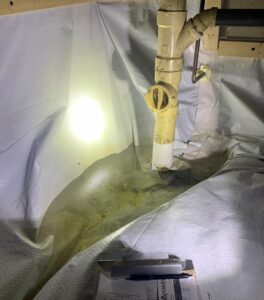 This photo was taken by an Acculevel project advisor in an encapsulated crawl space without waterproofing.
This photo was taken by an Acculevel project advisor in an encapsulated crawl space without waterproofing.
Water flooded the crawl space, seeping under the encapsulation material. Eventually, it found a way through the encapsulation material — most likely by eroding a seam. (Seams are sealed, but they’ll eventually fail when they’re water-logged.)
The water became stagnant, feeding mold growth inside what was a sealed crawl space. The solution to this issue required tearing out the DIY crawl space encapsulation and re-doing it — only this time we started with waterproofing. (Acculevel, like most professional contractors, does not warranty encapsulation if it’s done without waterproofing.)
Now that we’ve explained how crawl space encapsulation is done, let’s talk about why it’s so beneficial for you, your family, and your home.
There are 3 Major Benefits of Crawl Space Encapsulation
Professional crawl space encapsulation benefits you in three major ways: it improves your health, protects the strength and stability of your home, and increases your home’s value.
Improved Air Quality Protects Your Health
Crawl space encapsulation eliminates multiple contributors to poor air quality.
Crawl Spaces Entice Allergens and Worse
Microorganisms like pollen, mold, and mildew —even bacteria and viruses — can all flourish in an open crawl space with excess moisture. These tiny invaders are everywhere and can come from anywhere. You can carry them into your living space on your shoes or clothes, let them in a window to get fresh air, etc.
But sealing the vents, waterproofing the crawl space, and installing an encapsulation barrier all restrict these airborne intruders that are typically found in the area beneath your home:
A Dehumidifier Will Prevent Moisture Buildup
The whole-home dehumidifier also plays a critical role in healthy air circulation. Humid air can be literally bad for your health because it can “feed” microorganisms you don’t want in your crawl space.
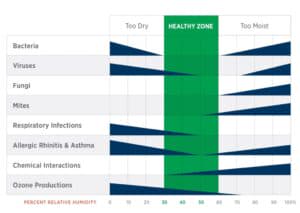
This chart is the result of a study done by ASHRAE (American Society of Heating, Refrigerating, and Air-Conditioning Engineers). It summarizes the different types of harmful organisms that can thrive in crawl spaces, as well as their ideal humidity levels.
If you have any allergies, you know exactly how frustrating these symptoms can be. But mold growth is a threat to even the healthiest of people. It’s especially dangerous for those with asthma, chronic respiratory disease, and compromised immune systems. Mold exposure increases the risks of developing allergies and asthma in infants and young children because their immune systems are still growing.
Encapsulation Helps Maintain Your Home’s Structural Integrity
Excess moisture in your crawl space doesn’t just threaten your well-being; it also degrades the structural stability of your foundation and wooden flooring.
Defend Your Foundation Against Ground Moisture
A good quality water drainage system doesn’t just improve the inside of your house; it also benefits your home’s foundation. Water can erode the ground around your foundation, causing it to settle unevenly. If you have a significant amount of rain (or live in a high water table area), too much water in the soil around your house can cause hydrostatic pressure — which leads to foundation cracks and bowing crawl space walls.
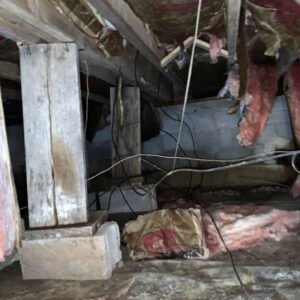 This photo was taken by an Acculevel project advisor during a free in-home assessment. The vapor barrier has decayed, the insulation is molding & falling, and the floor joists and columns are rotting.
This photo was taken by an Acculevel project advisor during a free in-home assessment. The vapor barrier has decayed, the insulation is molding & falling, and the floor joists and columns are rotting.
Preserve the Strength of Your Home’s Floors
But your wooden flooring system benefits more directly from encapsulating your crawl space. The encapsulation process will prevent excess moisture from accumulating, which causes wood rot and decay. The number one cause of sagging and sloping floors is a wet crawl space.
Keep Pests and Vermin Out of Your Home’s Crawl Space
Another way encapsulated crawl spaces protect your home’s structure is by discouraging unwanted “visitors.” We’re talking about insects like termites and powderpost beetles, as well as rats and mice. These invaders often enter through vents or through the sill plate and foundation wall. Both of these pathways are sealed off with foam insulation. While they can dig through spray foam with enough determination, it’s usually enough of a barrier to deter them.
Encapsulating Your Crawl Space Can Help Your Budget
Once the crawl space is encapsulated, you will have cleaner, drier air in your home. For many of us, this one argument is enough; after all, what’s more important than your health? What else does every homeowner need? To save money!
Lower Utility Costs
Controlling humidity levels has a nice side effect to offer. In addition to being healthier for you to breathe, it’s also easier for your HVAC system to process. This will increase your HVAC’s efficiency and extend the life of the equipment. Drier air also feels cooler than humid air —allowing you to set your air conditioning a degree or two higher without sacrificing physical comfort.
Depending on the size of your home and the age of your HVAC, you can expect a 10-20% decrease in your utility bills.
Provide Needed Storage Space
Depending on how accessible the entrance is, professional crawl space encapsulation can also create usable storage space. Depending on your situation, this can free up closet space in your living area or eliminate the need for a costly storage unit for out-of-season decorations or clothing.
Increase Your Home’s Resale Value
All of these benefits translate to a more desirable home, not just for you now but also when you decide to move. We’ll admit, home buyers tend to prioritize an extra bedroom or larger kitchen over an encapsulated crawl space. But they still value a clean, healthy, and energy-efficient home. And when faced with a choice between an encapsulated crawl space and one full of mold and wet insulation… the odds are firmly in your favor!
Is It Time to Encapsulate Your Crawl Space?
You need an experienced crawl space repair company that is reputable and reliable. Before you sign a contract for any service, always verify the company is insured and accredited by the Better Business Bureau.
If you live in Indiana or the surrounding states, contact the crawl space encapsulation pros at Acculevel! We’ll schedule an appointment with one of our experienced project advisors, who will listen to your concerns, evaluate your home, and help you determine the best course of action for you. We’ve helped more than 30,000 homeowners keep their homes strong and healthy for years to come. Let us show you how!

